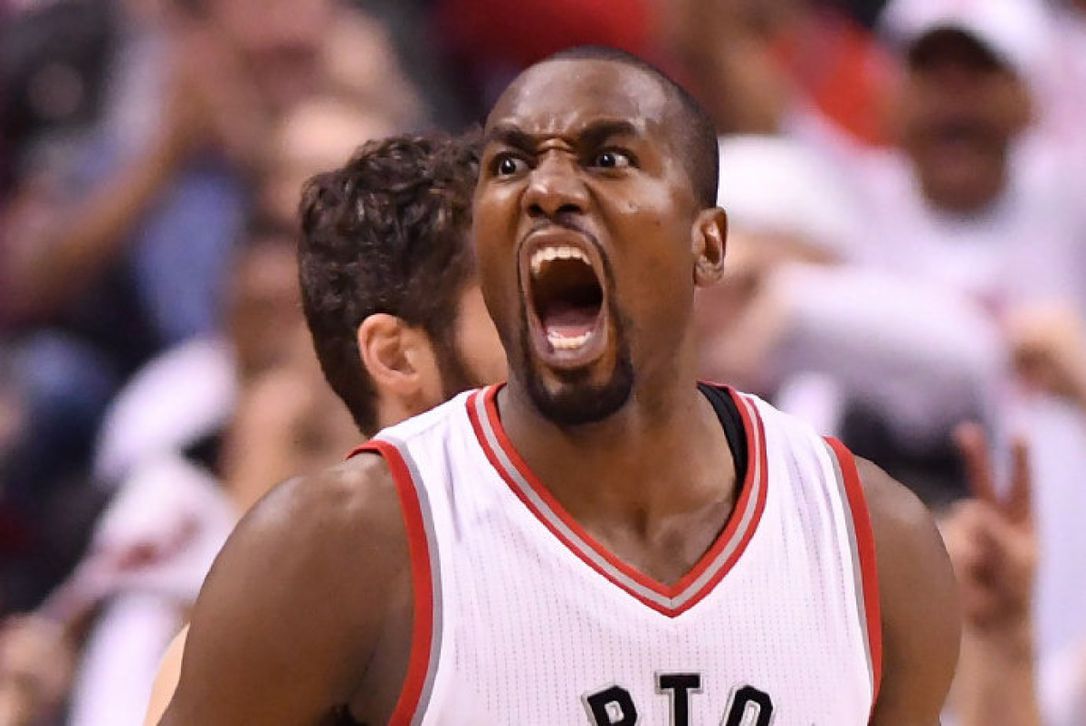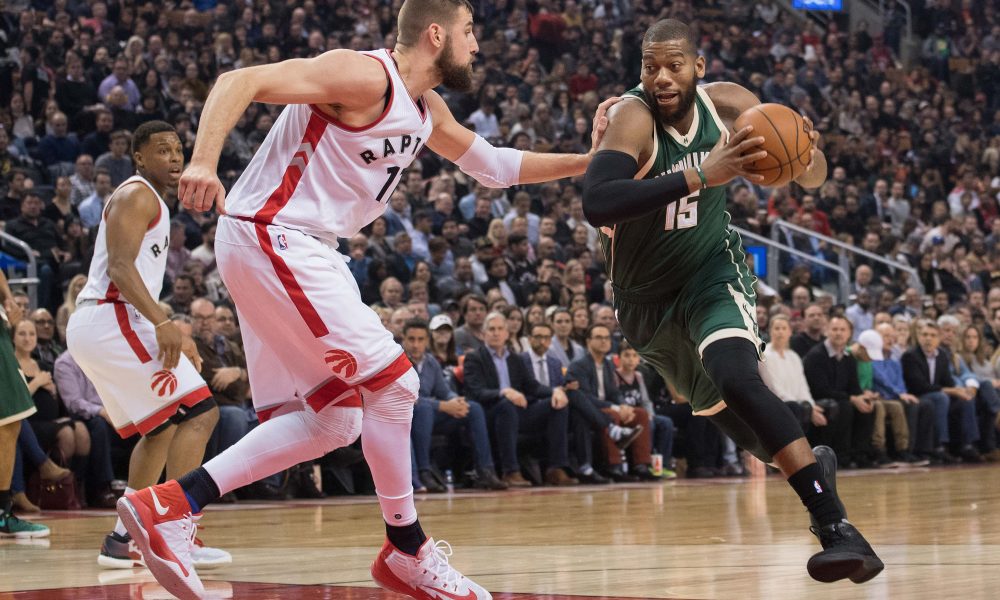Since the Toronto Raptors became a good basketball team, a disproportionate amount of their success has been driven by their bench. The bench has contributed more to outscoring opponents than the starters, which is not true of most successful basketball teams. Using the two most common configurations for bench and starter lineups, let’s look at point differentials according to Cleaning the Glass. I include four bench players and one starter as a bench lineup for this chart, as the Raptors haven’t always given meaningful minutes to five bench players at a time.
| Year | Bench point differential per 100 possessions | Starter point differential per 100 possessions |
| 2017-18 | +14.9 | +9.1 |
| 2016-17 | +13.1 | -12.4 |
| 2015-16 | +18.7 | -3.1 |
| 2014-15 | +17.5 | +2.6 |
Those bench lineups have deployed bigs as varied as Patrick Patterson, Lucas Nogueira, Pascal Siakam, and Tyler Hansbrough. They’ve employed guards as varied as Cory Joseph, Lou Williams, Delon Wright, and Terrence Ross. They have sometimes – but not always – included Kyle Lowry. It’s been a lot of different players but always the same result.
The least the bench lineup has outscored the starting lineup has been 5.8 points per 100 possessions. The largest difference has been an outrageous 25.5 points per 100 possessions. That’s far worse than the difference between 2017-18 Steph Curry, Klay Thompson, Andre Iguodala, Kevin Durant, and Draymond Green (+10.5) and 2010-11 Jarrett Jack, DeMar DeRozan, Linas Kleiza, Andrea Bargnani, and Reggie Evans (-9.0).
There’s a number of different reasons to explain why Toronto’s bench has been so much better than its starters for so many years in a row, and some will surely leak into this piece. I’m not here to explain that. I’m here to answer the simple question of whether the bench will continue to dominate. And if so, what will it look like?
First of all, what will the Raptors’ bench look like? It will surely include some mainstays from last year, including Fred Van Vleet and Delon Wright in the backcourt. Pascal Siakam may be the bench’s power forward, or he may seize the starting job at some point during the season. C.J Miles may play small forward, but so too could Danny Green or even O.G Anunoby. As Jakob Poeltl is gone, the Raptors cannot play the same lineup as last year, but Serge Ibaka or even Jonas Valanciunas – if the Raps opt to play small – could play center for the bench.
My guess is that barring further trades, the most common bench lineup will feature Van Vleet, Wright, Miles, Siakam, and Ibaka. Playing a horde of wings with the starters will allow them defensive switchability from every position other than Valanciunas’ while also maximizing shooting, ballhandling, and playmaking. On nights when the opposing power forward is too big for Anunoby or Kawhi Leonard, the Raptors will start Ibaka alongside Valanciunas; however, those lineups will likely see their minutes dwindle from last year.
The bench will be similar to last year but not the same. Poeltl will be missed as an incredible screen-setter, offensive rebounder, finisher, and rim protector. While Ibaka does none of those things as well as Poeltl, he has his own skills. As for screen-setting, he can still finish on the roll when he decides to actually make contact.
More importantly, Ibaka is a far superior shooter to Poeltl. The space his shooting provides on offence should further open up Wright’s shifty drives and kick-outs. Last year, Toronto’s bench took 82.4 percent of their shots from 3 or at the rim. Ridiculously, that was more than the Rockets’ 81.8 percent. However, there were spaces for improvement on the offensive end regardless.
Toronto’s bench will surely shoot more midrange shots with Ibaka manning the middle, but they will also convert other shots at a higher rate. Last year, they finished at the rim at a rate of 62.6 percent, which is low. That was because only Van Vleet and Miles were threatening shooters from deep, and opponents could wall off the paint on defence. Every player on last year’s bench struggled finishing over length except perhaps Poeltl. Without Poeltl’s defender lurking in the paint this year, they will all surely shoot better at the rim. In fact, in the 238 possessions during which Ibaka played center last year, the Raptors shot an absurd 78.8 percent at the rim versus a team-wide 63.2 percent when Poeltl played the same position.
Here Van Vleet tees up a wide-open triple because of Ibaka’s spacing on the other side of the court. Al Horford is forced to position himself outside of the paint on the weak side, leaving no help defence for the action on the strong side. Van Vleet’s defender sinks low on the screen to take away the roller, which opens up Van Vleet’s triple. Ibaka’s role is subtle, but rest assured: if Poeltl were in his place, Van Vleet does not see daylight on the jumper.
All this is to say that the Raptors bench will surely be fine on offence this year. If they miss Poeltl’s screen-setting, Greg Monroe can be shuffled into the mix. Jonas Valanciunas could even get some run with the bench, as he offers all the same benefits as Poeltl while being a far better scorer and defensive rebounder. It’s conceivable that the bench is better on offence this year than last.
The bench should also continue to be a strong defensive unit. Siakam is a defensive monster, and Wright and Van Vleet are incredible at containing penetration from the perimeter. Though Ibaka isn’t, at this juncture of his career, at the level of Poeltl as a rim protector, he is still solid. He held opponents to a field goal percentage of 58.1 when shooting from six feet or less, which is good. He also had a block rate of 2.4 percent: again good, not great. He still makes highlight plays helping from the weak side.
One weakness of Ibaka on the defensive end is switching onto guards and speedier players. Ibaka defended the ball-handler in the pick-and-roll far more frequently than any other big on the team, and he was by far the worst defender on the team in those situations. He also graded out poorly at defending in isolation, giving up more points per possession than Poeltl or Valanciunas, per nba.com. Furthermore, Ibaka ran with a slower average pace than Poeltl on defence – another sign pointing towards him being less capable of defending on the perimeter.
Poeltl was superior on all accounts, but you don’t need five elite defenders to craft an elite defence. Three will do. C.J Miles remains a defensive sieve, capable only of switching away from the action and fouling when required. If the bench struggles on defence, Green or Anunoby could fill in on the wing, boosting the defence dramatically. The point is that Ibaka doesn’t need to be as good as Poeltl; there are other solutions if problems arise.
Furthermore, many of Ibaka’s defensive issues will be mitigated by playing him at the center position. Though Poeltl was sometimes asked to switch onto the perimeter, especially late in the shot-clock, the team has experience dropping its center low in practically every action. Ibaka could mirror Valanciunas’ coverage, and the team wouldn’t miss a beat. There is evidence that Ibaka is quite solid in those situations; when playing center last year, the Raptors allowed opponents very few shots at the rim, and opponents shot horrific percentages at the rim (56.9) and behind the arc (20.7), per Cleaning the Glass. Ibaka-at-center did allow opponents heaps of offensive rebounds, but so too did Poeltl. The team was elite defensively regardless in both situations. Just for fun, here’s Ibaka dropping in the pick-and-roll, getting out of position on the driver, but making up for it with elite length and closing speed.
Van Vleet, Wright, Miles, Siakam, and Ibaka should therefore be a strong unit on both offence and defence. They haven’t played any minutes together, but especially as chemistry grows throughout the year, they should be able to near the highs of last year’s group. The defence will likely be worse, and last year’s numbers may well have been inflated anyway. The upcoming bench lineup should not be able to obtain a point differential of +14.9 unless Lowry gets run with the bench (unlikely, to save his body for the playoffs), but assuming health and consistent minutes for the above quintet, it would be reasonable to expect a point differential nearing +10.
So we’ve determined that the bench will be good. But that likely won’t be better than the starters. Last year was the first year in which the Raptors starters reached competency, let alone dominance. They were an incredible unit. Among lineups with 300 or more minutes played together, the Raptors starters boasted the sixth-highest net rating. The bench players just so happened to be second-best.
It is reasonable to expect the starters to be even better this year. Kawhi Leonard is obviously a top-tier player. His teams have consistently been better with him on the court than with him off since his rookie year in 2011-12. It’s outside the scope of this piece to delve into what the starters will look like as a unit, but it’s believable that they’ll have a superior point differential to last year.
The bench will still be awesome; however, so too will be Toronto’s starting lineup. For the first time since the Raptors became relevant again, I expect the starters to claw their way to an equal or even superior point differential to the bench. It will be nice to watch Van Vleet and co. whirring around the court and wreaking havoc on opponents in the second quarter. It will be even nicer watching them no longer having to dig the team out of first-quarter deficits.



